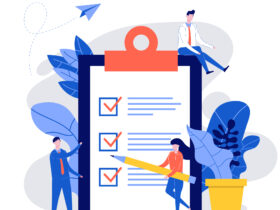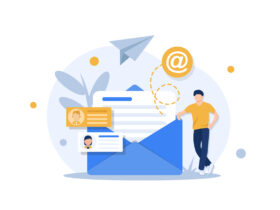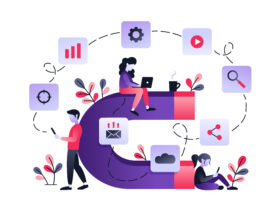Inbound marketing perfectly complements outbound marketing efforts.
Inbound marketing is one of the most powerful forms of marketing. It’s built on creating real value for the customer — these efforts often go well beyond just what you bring to market, too.
When you go out of your way to engage with a brand because they have something awesome to share, something great to watch, something neat to read, listen to, or whatever, what you’re doing is participating with their inbound marketing strategies.
Now…
…what if YOU attracted leads & customers by creating a phenomenal experience?
Would you not see your business flourish?
In this article, we’re sharing an introductory guide to inbound marketing for small businesses. Follow along and you’re sure to create success.
What is inbound marketing?
Inbound marketing is a marketing strategy that focuses on creating and sharing content that appeals to your target audience. The goal is to attract new customers and convert them into leads and eventually, paying customers.
Inbound marketing is effective because it’s not interruptive like outbound marketing. Outbound marketing interrupts potential customers with ads, cold calls, emails, etc. Inbound marketing, on the other hand, attracts customers to your brand and then builds trust and credibility with them over time so that they eventually buy from you.
Inbound marketing is sometimes also referred to as permission marketing.

How does inbound marketing work?
The inbound marketing process typically consists of 4 stages:
Attract
This is the first stage of inbound marketing where you generate awareness and interest in your brand and its products or services among your target audience. You do this by creating compelling content that is optimized for search engines and sharing it on your website and across the web.
Convert
In the second stage, you convert leads into customers by offering them valuable content that they can use. This might be in the form of a white paper, an e-book, or a helpful blog post.
Close
In the third stage, you close deals and make sales by nurturing your leads and providing them with the information they need to make a buying decision.
Delight
In the fourth and final stage, you build loyalty and brand advocates by continuing to provide them with valuable content and an outstanding experience even after they’ve made a purchase.
What are the benefits of inbound marketing?
There are many benefits of inbound marketing, but here are some of the most important ones:
- More leads – Inbound marketing generates more leads than outbound marketing.
- Higher quality leads – Inbound marketing also generates higher quality leads than outbound marketing. This is because inbound leads are typically more interested in your brand and its products or services since they came across your content on their own accord.
- Lower cost per lead – Inbound marketing is also more cost-effective than outbound marketing. This is because you’re not wasting your time and money on leads that are not interested in what you have to offer.
- More brand awareness and recognition – By creating and sharing compelling content, you’ll increase brand awareness and recognition among your target audience.
- More sales – The ultimate goal of inbound marketing is to generate more sales and revenue for your business.
The value of inbound marketing goes well beyond that which you get from the sales and marketing side, too. Because you’re creating great information, products, and services, you’re also empowering your team.
A great, informative piece that helps your customers understand how your products work is just as valuable for employee training. A well-documented product or service is super helpful for those handling customer service – since they will have a great deal of information to work from, too.
The list goes on and on, and every small business will benefit from inbound marketing in unique and wonderful ways!

Types of inbound marketing strategies
There are many inbound marketing strategies, but some of the most important ones include:
Search engine optimization (SEO)
SEO is the process of optimizing your website and its content for Google search. This helps you rank higher in search results, which leads to more website visitors.
Here is a super simple guide to SEO:
- Pick a keyword that fits the intent/focus of your page
- Apply that primary keyword to its title, meta, URL, H1, and body content
- Add in sub-topics + supportive keywords for the main topic
- Finish out by creating the best piece of content you can
- Share your work and start building links to that page
Repeat this process with other pages on your site — each having a unique primary keyword and focus — and you’ll soon have an optimized site!
Social media marketing
Social media marketing involves creating and sharing content on social media platforms like Facebook, Twitter, and LinkedIn. This helps you build relationships with potential and current customers.
Social media marketing is pretty simple:
- Look at what people like sharing
- Create your own content for that space
- Kick up conversations and engage with your audience
- Point people back to your site
Social media is all about interacting with people. So, get on out there (on the platforms your customers frequent) and start building connections!
Content marketing
Content marketing is all about creating and sharing helpful and compelling content. This might be in the form of blog posts, e-books, infographics, videos, etc.
Content marketing is powerful once you get the hang of it.
If you’re not the type to do a lot of writing, video, podcasting, and all that, you can always hire a freelancer or use a content marketing company. All that’s needed is an outline of the type of content you want and they’ll get to work producing it.
Email marketing
Email marketing involves sending emails to potential and current customers. The goal is to build relationships and eventually convert them into paying customers.
Here are a few email marketing platforms to check out:
- Mailchimp
- Constant Contact
- Aweber
Once you’ve got a basic email list setup, you can then begin reaching your audience through email newsletters and one-off shares. Focus on delivering quality and value — treat your email marketing much like you would your blog. Then, do an occasional promotional piece when the time is right such as during a sale or new product release cycle.
Lead generation
Lead generation is the process of generating leads, or potential customers, for your business. This can be done through various means, such as SEO, social media marketing, content marketing, etc.
Essentially — take those things from above and build upon them.

How to create and execute an inbound marketing plan
Creating an inbound marketing plan doesn’t have to be difficult. Here are the steps you need to take:
1. Define your goals and objectives – The first step is to define your goals and objectives. What do you want to achieve with inbound marketing?
2. Understand your audience – Next, you need to understand your audience. Who are you trying to reach with your inbound marketing efforts?
3. Create buyer personas – Once you understand your audience, you can create buyer personas. These are fictional characters that represent your ideal customers.
4. Research keywords – Once you have your buyer personas, you need to research keywords. What terms and phrases are they searching for online?
5. Create and publish content – The next step is to create and publish content. This might be in the form of blog posts, e-books, infographics, videos, etc.
6. Promote your content – Once you have published your content, you need to promote it. This can be done through social media, email marketing, paid advertising, etc.
7. Generate and nurture leads – The final step is to generate and nurture leads. This involves generating leads through your website and then nurturing them with targeted content and emails.
By following these steps, you’ll be well on your way to creating a successful inbound marketing plan for your small business!
In…bound to your success
Inbound marketing is a great way to attract more leads and customers to your business. By creating and sharing compelling content, you’ll be able to build trust and credibility with your target audience. And, by using the various inbound marketing strategies mentioned, you’ll generate more sales and revenue.
Are you ready to get started with inbound marketing?
Start with the insights shared in this guide, track your efforts, and double down on what works. Repeat this and you’ll see the true power of inbound marketing!























Leave a Reply